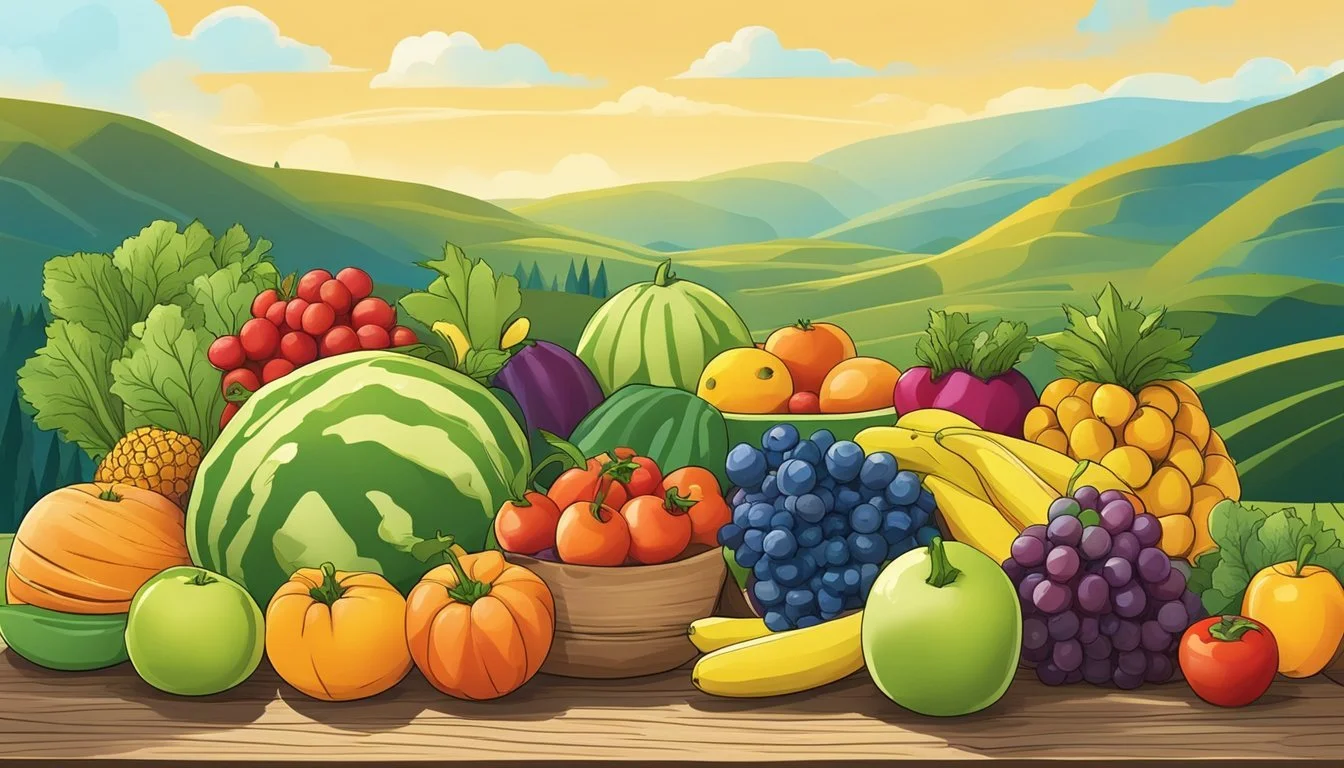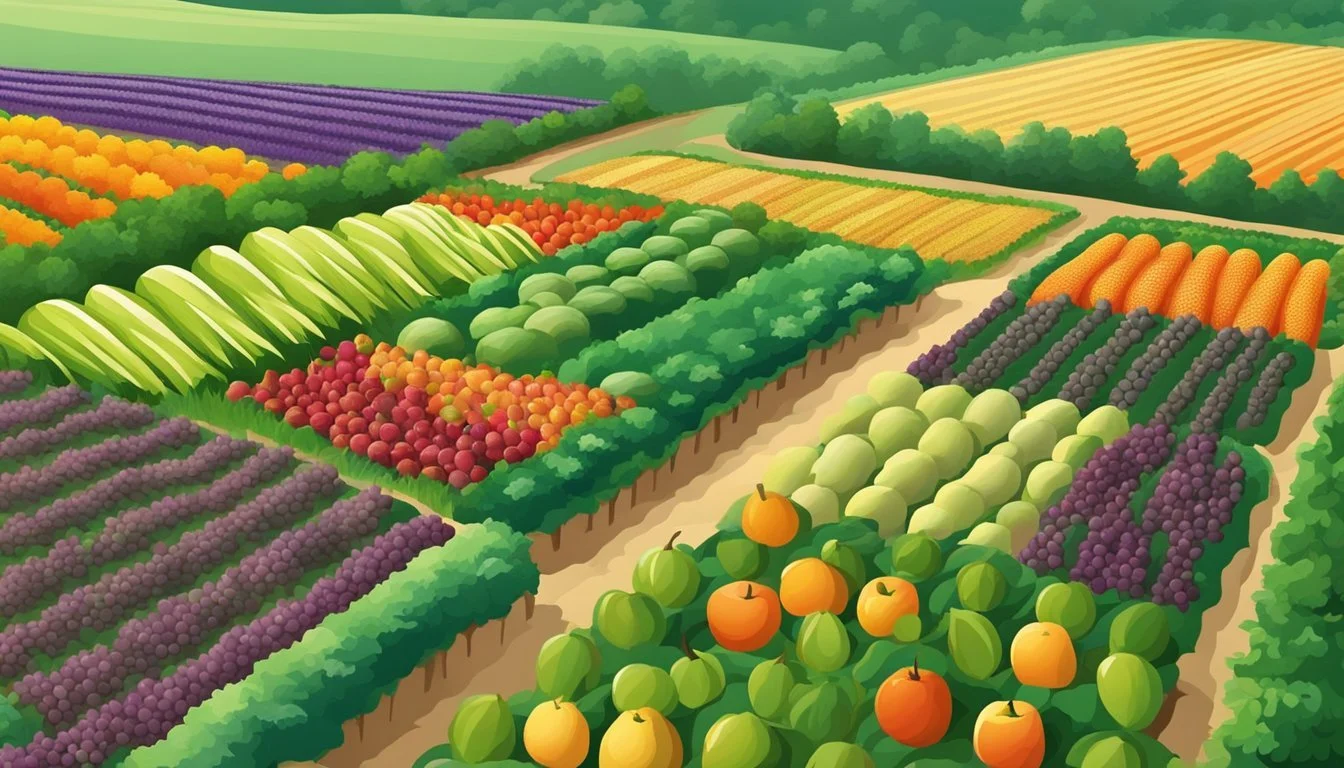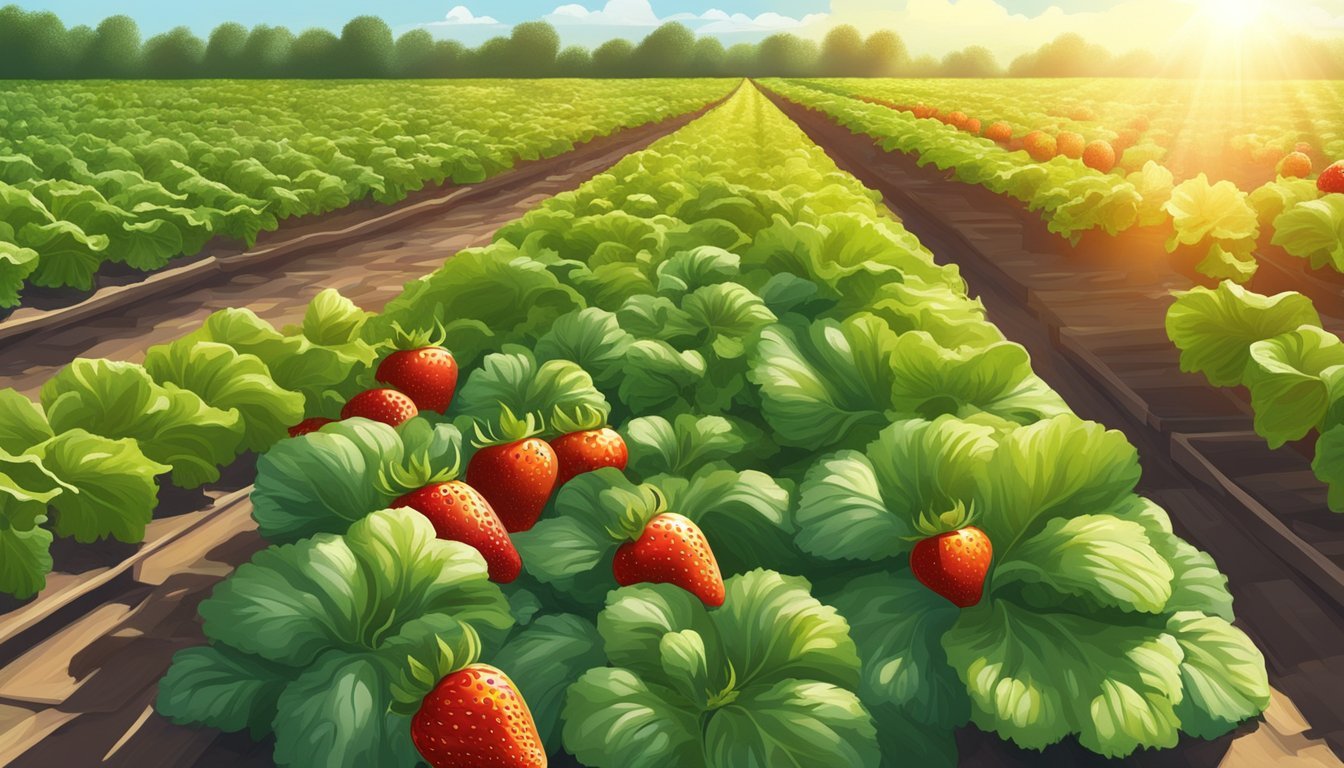Connecticut Seasonal Fruit & Veg Guide
Your Year-Round Companion
Connecticut's diverse climate allows for a variety of fruits (What wine goes well with fruit?) and vegetables to flourish seasonally, offering residents and visitors alike the opportunity to experience the fresh, local produce available throughout the year. With four distinct seasons, the state’s agricultural calendar presents a rotating selection, with each part of the year bringing its specialties to the farm stands and local markets. Eating seasonally in Connecticut not only provides the freshest taste and nutritional benefits but also supports local farmers and the environment by reducing transportation and storage impacts.
Spring in Connecticut is marked by the arrival of tender greens and the first roots, while summer boasts an abundance of berries, cherries (how long do cherries last?), tomatoes, and stone fruit. As fall approaches, orchards are busy with apple and pear harvests, and fields are full of squashes and pumpkins heralding the harvest season. Even winter has its yields with stored root vegetables and hearty greens. For enthusiasts of farm-to-table eating, understanding this seasonal cycle is essential to enjoy the bounty that Connecticut farms have to offer. The state’s Department of Agriculture and various resources provide guides and calendars to help residents stay informed about what's available throughout the year.
What’s in Season in Connecticut Right Now?
Understanding Seasonality in Connecticut
Connecticut’s diverse climate has a significant influence on the availability of fresh fruits and vegetables throughout the year. This guide outlines how seasonal changes and weather patterns affect local produce.
The Impact of Weather on Harvest
In Connecticut, weather conditions play a critical role in determining the harvest times and quality of the produce. For instance, spring with its unpredictable temperature swings can affect the delicate blooms of fruit trees, dictating the success of fruits like cherries. Summer offers warm weather, conducive to growing a variety of crops including corn and tomatoes, but extreme heat or droughts can adversely impact yield. The transitional period of fall supports the harvest of cool-weather crops like pumpkins and apples (how long do apples last?), while winter’s cold can be challenging, although technologies like greenhouses enable certain produce to be grown year-round.
Connecticut's Growing Seasons
Spring: Late April to June marks Connecticut’s spring growing season. Cool-weather crops thrive in these months.
Spring Crops: Spinach, lettuce, and fiddleheads.
Summer: June through August is peak summer, ideal for growing a wide array of fruits and vegetables.
Summer Crops: Tomatoes, blueberries, and corn.
Fall: From September to November, the fall harvest begins.
Fall Crops: Apples and root vegetables like carrots.
Winter: Though growth slows, December through March still sees some production.
Winter Crops: Indoor greens and stored root vegetables.
By understanding Connecticut’s growing seasons, consumers can make informed choices about the freshest, locally available produce to support both their health and the local economy.
Spring Harvest in Connecticut
As spring awakens the landscape of Connecticut, local farms boast an array of fresh produce. The state's diverse climate and fertile soils become evident through the seasonal offerings harvested at this time of year.
Early Spring Vegetables
In the early spring months, particularly April, Connecticut farms begin to harvest a variety of hardy vegetables that thrive in the cooler temperatures. Among these, asparagus stands out as a sought-after crop, followed closely by parsnips which can be sweetened by the winter frost. Tender pea greens and piquant arugula (how long does arugula last?) start to appear in farmers' markets alongside the versatile chard. Additionally, fava beans (how long do fava beans last?) offer a bright, buttery flavor that becomes a staple for springtime dishes. Farms also gather green onions or scallions, which provide a mild, fresh bite to a variety of recipes.
Fiddleheads, the curled fronds of young ferns, make their brief but celebrated appearance, often foraged in the wild rather than farmed.
Fresh lettuce varietals begin to blanket fields, and the aromatic presence of mint, thyme, and parsley signals the rejuvenating essence of the season.
Producers and foragers alike harvest nettles, which require careful handling but can be cooked into nutritious, delicious meals.
Early Spring Harvest Availability Asparagus Early April - June Parsnips April (from winter storage or overwintered crop) Pea Greens April - May Arugula April - May Chard April - May Fava Beans Late April - May Green Onions/Scallions April - May Lettuce April - June Mint April - September Parsley April - September Thyme April - September Nettles April - May
Late Spring Fruits
As the season progresses into May, Connecticut's farmlands offer the first fruits of the year. Rhubarb, with its tart and tangy flavor, is commonly found during the late spring, perfect for pies and preserves. This perennial plant is often one of the first signs of fruit harvests to come.
Late Spring Harvest Availability Rhubarb May - June
As the days grow longer and warmer, these fruits and vegetables make their way from the rich Connecticut soil to local restaurants and dining tables, allowing residents and visitors alike to savor the freshness and quality of the state's spring bounty.
Summer Abundance in Connecticut
Connecticut thrives with a rich tapestry of produce during the summer months, making it a perfect time for farm-to-table enthusiasts to enjoy fresh fruits and vegetables. With a season that progresses from the tender early harvests of June to the full bounty of August, there are distinct waves of produce to be enjoyed throughout the summer.
Early Summer Produce
In June, Connecticut's farms begin to buzz with activity as the first fruits of the season reach maturity. Strawberries lead the charge, their sweet red berries a herald of the abundance to come. Following closely are the tart cherries and the beginning of the blueberry season, offering a burst of flavor for early summer pallets. Vegetables also make a bold appearance with crisp Cucumbers, and a variety of leafy greens, such as Kale, all being harvested.
Fruits: Strawberries, Cherries
Vegetables: Cucumbers, Kale, Kohlrabi, Morels (Mushrooms)
Herbs: Oregano
Mid-Summer Crop Variety
July brings with it an expansion of diversity in Connecticut's fruit and vegetable offerings. Blueberries and Raspberries come into full swing, while the first of the Peaches and Nectarines start to ripen, adding juicy options to the mix. The vegetable selection grows with Corn beginning to peak, accompanied by Tomatoes, Eggplant (What wine goes well with eggplant?), and Green Beans. Zucchini (What wine goes well with zucchini?) and its delicate flowers, Zucchini Blossoms, are also ready for harvest, perfect for summer dishes.
Fruits: Blueberries, Raspberries, Peaches, Nectarines
Vegetables: Corn, Tomatoes, Eggplant, Green Beans, Zucchini, Peppers (Sweet), Carrots
Herbs: Basil, Garlic
Late Summer Harvest
As August arrives, the focus shifts to the robust late summer harvest. This is the prime time for sweet Melons and a variety of Squash, including Summer Squash. Beans and Peas and Pea Pods reach their optimal flavor and freshness. A second wave of Tomatoes provides a continued supply for sauces and salads, while Cabbage and Broccoli begin to thrive in the warm yet tempering climate. Late August is also a signal for the ripening of seasonal staples such as Corn and a second harvest of blueberries.
Fruits: Melons, Late-Season Blueberries
Vegetables: Squash (Summer), Zucchini, Beans, Peas and Pea Pods, Tomatoes, Cabbage, Broccoli
Herbs: Basil (continues from July)
Connecticut's summer months boast an impressive variety of produce that reflects the state's agricultural richness, offering something fresh and local for every palate.
Fall's Rich Harvest
The fall season in Connecticut showcases a bountiful array of fruits and vegetables, marking a time of rich harvests and seasonal variety. The transition from early to late fall sees a shift in available produce, each with its own prime picking time.
Early Fall Varieties
In September, Connecticut's farms are abundant with the last of summer's offerings transitioning into the heartier selections of fall. Produce readily available during this period includes:
Apples: Various varieties begin to reach ripeness.
Pears: Soft and hard varieties both become available.
Plums: Including Italian prune plums, celebrated for their deep flavors.
Grapes: Suitable for eating fresh or making preserves.
Peppers: Offering a spectrum of flavors from sweet to fiery hot.
Potatoes: A staple with numerous varieties to choose from.
Cauliflower: Gaining popularity for its nutritional benefits.
Celery and Leeks: Essential for fall soups and stews.
Sweet Corn: Concluding its season, but still present at markets.
Mid to Late Fall Picks
As the calendar turns to October, the air grows chillier, and the harvest reflects the heartier demands of the season. Representative of this time are:
Squash (Winter): Including butternut, acorn, and spaghetti varieties.
Pumpkins: Beyond Halloween decorations, they're a culinary delight.
Onions: For flavoring a wide range of dishes.
Broccoli Raab: A leafy green with a tangy, slightly bitter taste.
Turnips and Rutabagas: Root vegetables that are sweetened by the frost.
Squash: Offering a sweet and nutty flavor, perfect for roasting.
Cantaloupes (how long does cantaloupe last?): Wrapping up their season before the first frost.
Watermelons: Typically harvested by mid-fall before colder temperatures set in.
Throughout the Northeast, particularly in Connecticut, these crops are harvested at optimal times to ensure maximum flavor and nutrition. Farmers and consumers alike look forward to the robust flavors that define the fall season.
Navigating Connecticut's Farm Markets
Connecticut's agriculture offers diverse farm markets with a bounty of in-season produce. Consumers can explore local flavors through farmers' markets and farm stands, engaging with the community and supporting the state's agricultural economy.
Local Farmers' Markets
Farmers' markets are a vibrant part of Connecticut's local food scene. They serve as a hub where shoppers can find a variety of fruits and vegetables that are in season. The Coventry Winter Farmers Market operates from mid-November to March, offering not only fresh produce but also craft goods, pasture-raised meat, and more.
Location: Coventry High School, 78 Ripley Hill Road
Hours: Sundays, 10 a.m. to 12:30 p.m.
Farmers from across the state gather at these markets, providing consumers with direct access to freshly harvested food and an opportunity to learn about where their food comes from.
Farm Stands and U-Pick Farms
Beyond the markets, farm stands and U-Pick farms are a staple in Connecticut. These establishments allow consumers to purchase fruits and vegetables directly from farms, ensuring peak freshness and flavor. U-Pick experiences add a hands-on aspect to shopping, as visitors can harvest their own produce such as berries, apples, and pumpkins, depending on the season.
Consumers should look for:
Farm Signs: Often handmade, signaling fresh produce for sale
U-Pick Opportunities: Seasonal offerings where consumers can pick their own fruits and veggies
By engaging with these outlets, customers support local farmers and advocate for sustainable agriculture within their communities.
Winter Offerings and Storage Crops
During the winter months of December, January, and February, Connecticut farms offer an array of storage crops and hearty vegetables capable of withstanding the cold Northeastern climate. These selections provide nourishing options that complement the seasonal farm-to-table approach.
Root Vegetables form the cornerstone of winter produce. With natural preservation qualities, they maintain freshness and nutrients through cold storage. Carrots, parsnips, and turnips are versatile for a range of dishes, from roasted sides to puréed soups.
Root Vegetables Availability Carrots December-Feb Parsnips December-Feb Turnips December-Feb
Cabbage and Brussels Sprouts (how long do brussels sprouts last?) thrive in cooler temperatures and are typically harvested in late fall, persisting through the winter. Their ability to stay fresh when stored properly makes them staples during these months.
Caleb's Cabbage – A robust variety brimming with vitamins, perfect for slaws or ferments.
Brady's Brussels Sprouts – Compact and flavorful, ideal for roasting or steaming.
Celeriac, a less common root with a nuanced flavor, is harvested in the fall and stores well into winter. It lends an earthy taste to gratins and mashes.
Escarole withstands winter’s chill. As a leafy green, it provides a bitter zest to balance the richer flavors of the season, shining in warm salads or wilted as a side.
Connecticut's winters necessitate a culinary creativity that draws on the robustness of storage crops and cold-hardy vegetables. These offerings sustain local cuisine and provide the foundation for nutritious, seasonal eating.








